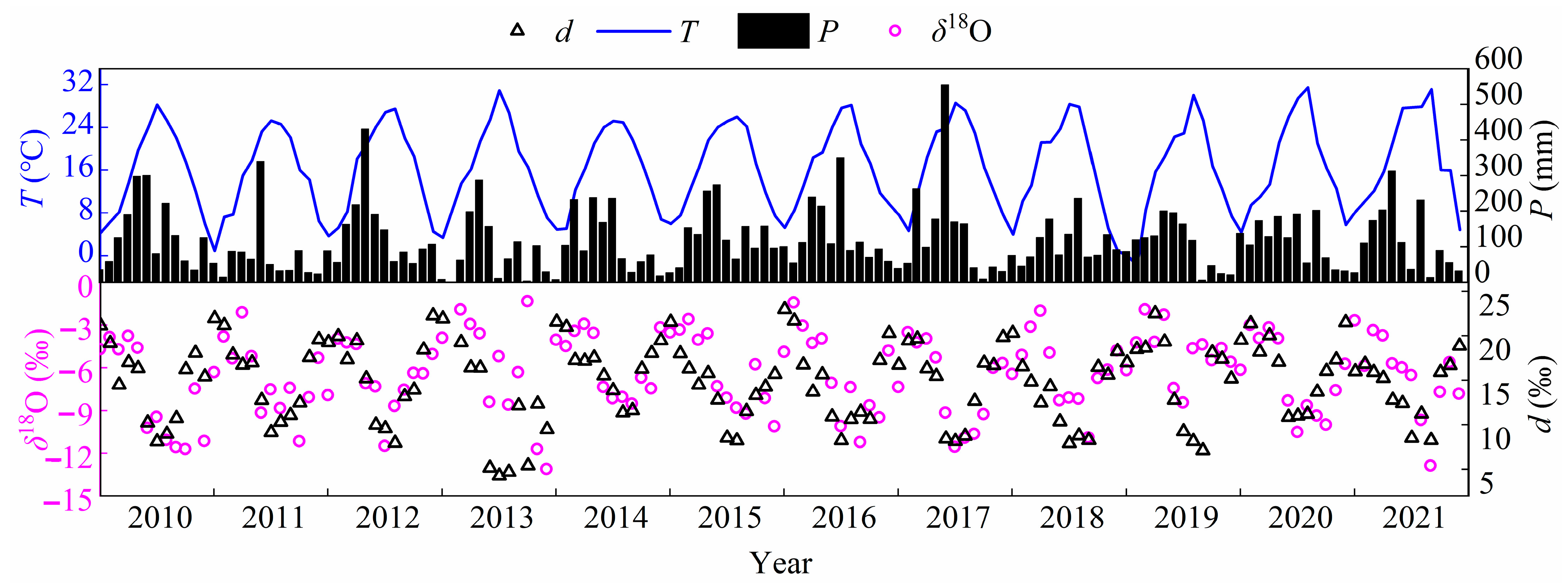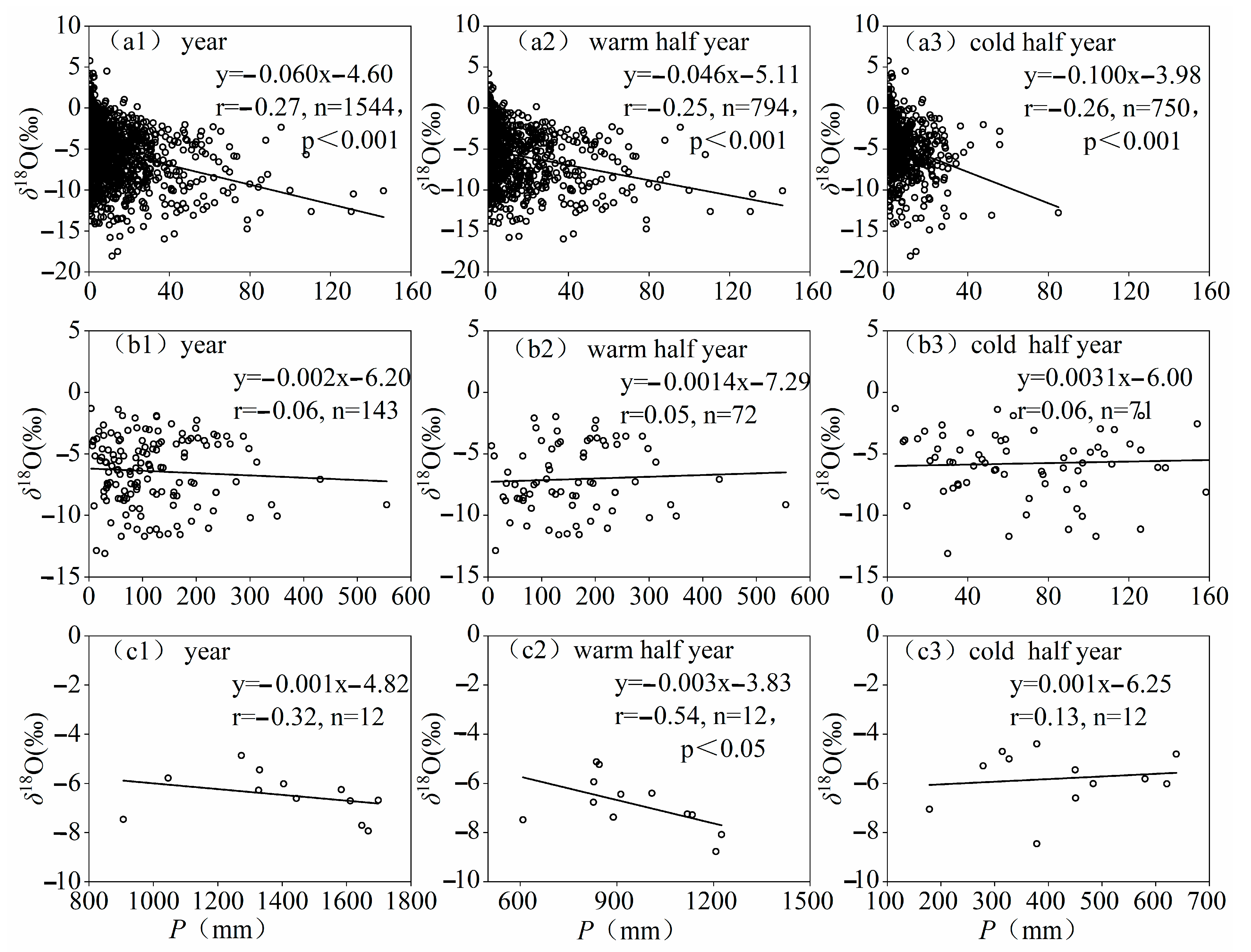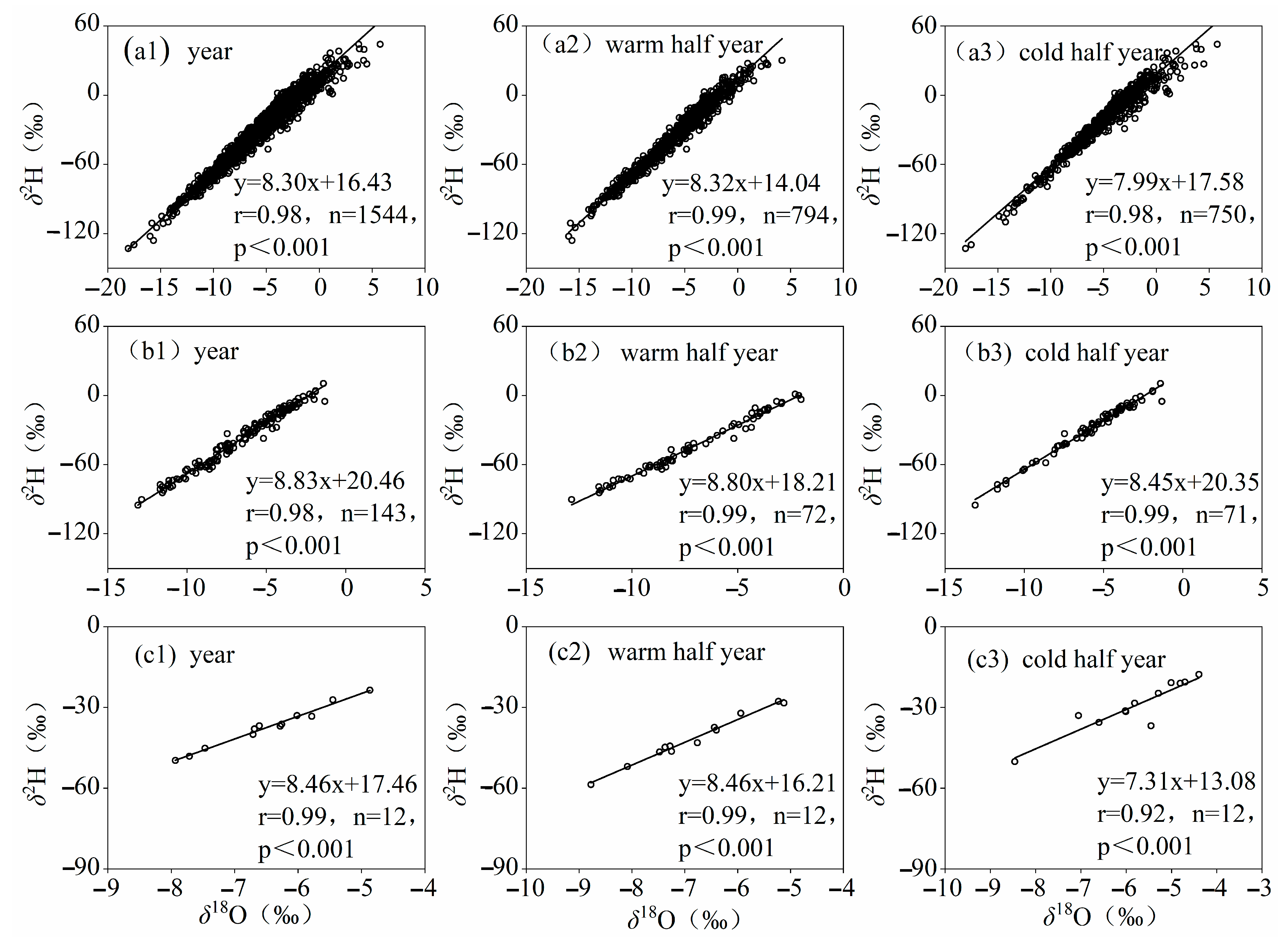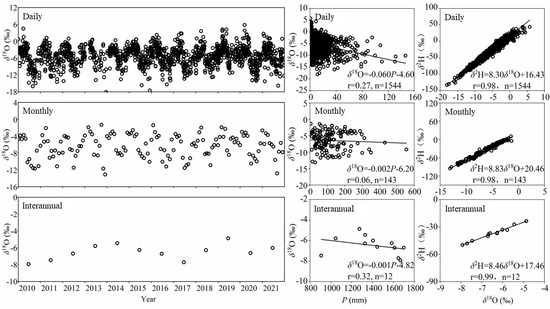Comparisons of Precipitation Isotopic Effects on Daily, Monthly and Annual Time Scales—A Case Study in the Subtropical Monsoon Region of Eastern China
Abstract
1. Introduction
2. Materials and Methods
2.1. Overview of the Study Area
2.2. Water Sample Collection
3. Results and Discussion
3.1. Temporal Variation in Stable Isotopes in Precipitation
3.2. Relationship between δ18Op and Precipitation Amount
3.3. Comparison of Meteoric Water Lines
4. Conclusions
Author Contributions
Funding
Data Availability Statement
Conflicts of Interest
References
- Wu, H.; Li, X.Y.; Zhang, J.; Li, J.; Liu, J.; Tian, L.; Fu, C. Stable isotopes of atmospheric water vapour and precipitation in the northeast Qinghai-Tibetan Plateau. Hydrol. Process. 2019, 33, 2997–3009. [Google Scholar] [CrossRef]
- Wu, H.; Huang, Q.; Fu, C.; Song, F.; Liu, J.; Li, J. Stable isotope signatures of river and lake water from Poyang Lake, China: Implications for river–lake interactions. J. Hydrol. 2021, 592, 125619. [Google Scholar] [CrossRef]
- Zhang, X.P.; Liu, J.M.; Wang, X.Y.; Nakawo, M.; Xie, Z.C.; Zhang, J.M.; Zhang, X.Z. Climatological significance of stable isotopes in precipitation over south-west China. Int. J. Climatol. 2010, 30, 2229–2239. [Google Scholar] [CrossRef]
- Laonamsai, J.; Ichiyanagi, K.; Kamdee, K.; Putthividhya, A.; Tanoue, M. Spatial and temporal distributions of stable isotopes in precipitation over Thailand. Hydrol. Process. 2021, 35, e13995. [Google Scholar] [CrossRef]
- Mosley-Thompson, E.; Thompson, L.G.; Grootes, P.M.; Gundestrup, N. Little ice age (neoglacial) paleoenvironmental conditions at siple station, Antarctica. Ann. Glaciol. 1990, 14, 199–204. [Google Scholar] [CrossRef]
- Tan, M. Circulation effect: Response of precipitation δ18O to the ENSO cycle in monsoon regions of China. Clim. Dyn. 2014, 42, 1067–1077. [Google Scholar] [CrossRef]
- Dansgaard, W. Stable isotopes in precipitation. Tellus 1964, 16, 436–468. [Google Scholar] [CrossRef]
- Tian, L.D.; Yao, T.D.; Schuster, P.F.; White, J.W.C.; Ichiyanagi, K.; Pendall, E.; Pu, J.; Yu, W. Oxygen-18 concentrations in recent precipitation and ice cores on the Tibetan Plateau. J. Geophys. Res. Atmos. 2003, 108. [Google Scholar] [CrossRef]
- Yao, T.; Masson-Delmotte, V.; Gao, J.; Yu, W.; Yang, X.; Risi, C.; Sturm, C.; Werner, M.; Zhao, H.; He, Y.; et al. A review of climatic controls on δ18O in precipitation over the Tibetan Plateau: Observations and simulations. Rev. Geophys. 2013, 51, 525–548. [Google Scholar] [CrossRef]
- Kong, Y.; Wang, K.; Li, J.; Pang, Z. Stable isotopes of precipitation in China: A consideration of moisture sources. Water 2019, 11, 1239. [Google Scholar] [CrossRef]
- Moore, M.; Kuang, Z.; Blossey, P.N. A moisture budget perspective of the amount effect. Geophys. Res. Lett. 2014, 41, 1329–1335. [Google Scholar] [CrossRef]
- Fritz, P.; Ch, F.J. Isotopes in cloud physics: Multiphase and multistage condensation process. In Handbook of Environmental Isotope Geochemistry. Volume 2, the Terrestrial Environment; Elsevier: New York, NY, USA, 1986; pp. 71–73. [Google Scholar]
- Araguás-Araguás, L.; Froehlich, K.; Rozanski, K. Stable isotope composition of precipitation over southeast Asia. J. Geophys. Res. Atmos. 1998, 103, 28721–28742. [Google Scholar] [CrossRef]
- Risi, C.; Bony, S.; Vimeux, F.; Chong, M.; Descroix, L. Evolution of the stable water isotopic composition of the rain sampled along Sahelian squall lines. Q. J. R. Meteorol. Soc. 2010, 136, 227–242. [Google Scholar] [CrossRef]
- Liu, Z.; Tian, L.; Yao, T.; Yu, W. Seasonal deuterium excess in Nagqu precipitation: Influence of moisture transport and recycling in the middle of Tibetan Plateau. Environ. Geol. 2008, 55, 1501–1506. [Google Scholar] [CrossRef]
- Chen, F.; Chen, J.; Wang, S.; Wu, X.; Zhang, Q.; Gao, M.; Kang, X.; Pu, Z.; Zhang, D. Below-cloud evaporation effect on stable water isotopes in precipitation at the eastern margin of Qinghai-Tibet Plateau. Hydrol. Process. 2022, 36, e14699. [Google Scholar] [CrossRef]
- Craig, H. Isotopic variations in meteoric waters. Science 1961, 133, 1702–1703. [Google Scholar] [CrossRef]
- Wang, S.; Zhang, M.; Hughes, C.E.; Crawford, J.; Wang, G.; Chen, F.; Du, M.; Qiu, X. Meteoric water lines in arid Central Asia using event-based and monthly data. J. Hydrol. 2018, 562, 435–445. [Google Scholar] [CrossRef]
- Zhang, X.P.; Liu, J.M.; Nakawo, M.; Xie, Z.C. Vapor origins revealed by deuterium excess in precipitation in southwest China. J. Glaciol. Geocryol. 2009, 31, 613–619. [Google Scholar]
- Zhang, X.P.; Yang, Z.L.; Niu, G.Y.; Wang, X.Y. Stable water isotope simulation in different reservoirs of Manaus, Brazil, by Community Land Model incorporating stable isotopic effect. Int. J. Climatol. A J. R. Meteorol. Soc. 2009, 29, 619–628. [Google Scholar] [CrossRef]
- Cai, Z.; Tian, L. Atmospheric controls on seasonal and interannual variations in the precipitation isotope in the East Asian monsoon region. J. Clim. 2016, 29, 1339–1352. [Google Scholar] [CrossRef]
- Yu, W.; Wei, F.; Ma, Y.; Liu, W.; Zhang, Y.; Luo, L.; Tian, L.; Xu, B.; Qu, D. Stable isotope variations in precipitation over Deqin on the southeastern margin of the Tibetan Plateau during different seasons related to various meteorological factors and moisture sources. Atmos. Res. 2016, 170, 123–130. [Google Scholar] [CrossRef]
- Guo, X.; Gong, X.; Shi, J.; Guo, J.; Domínguez-Villar, D.; Lin, Y.; Wang, H.; Yuan, D. Temporal variations and evaporation control effect of the stable isotope composition of precipitation in the subtropical monsoon climate region, Southwest China. J. Hydrol. 2021, 599, 126278. [Google Scholar] [CrossRef]
- Liu, J.; Song, X.; Yuan, G.; Sun, X.; Yang, L. Stable isotopic compositions of precipitation in China. Tellus B Chem. Phys. Meteorol. 2014, 66, 22567. [Google Scholar] [CrossRef]
- Wu, J.; Ding, Y.; Ye, B.; Yang, Q.; Zhang, X.; Wang, J. Spatio-temporal variation of stable isotopes in precipitation in the Heihe River Basin, Northwestern China. Environ. Earth Sci. 2010, 61, 1123–1134. [Google Scholar] [CrossRef]
- Pang, H.; He, Y.; Lu, A.; Zhao, J.; Ning, B.; Yuan, L.; Song, B. Synoptic-scale variation of δ18O in summer monsoon rainfall at Lijiang, China. Chin. Sci. Bull. 2006, 51, 2897–2904. [Google Scholar] [CrossRef]
- Wu, H.; Zhang, X.; Xiaoyan, L.; Li, G.; Huang, Y. Seasonal variations of deuterium and oxygen-18 isotopes and their response to moisture source for precipitation events in the subtropical monsoon region. Hydrol. Process. 2015, 29, 90–102. [Google Scholar] [CrossRef]
- Li, G.; Zhang, X.; Xu, Y.; Wang, Y.; Wu, H. Synoptic time-series surveys of precipitation δ18O and its relationship with moisture sources in Yunnan, southwest China. Quat. Int. 2017, 440, 40–51. [Google Scholar] [CrossRef]
- Zhou, H.; Zhang, X.; Yao, T.; Hua, M.; Wang, X.; Rao, Z.; He, X. Variation of δ18O in precipitation and its response to upstream atmospheric convection and rainout: A case study of Changsha station, south-central China. Sci. Total Environ. 2019, 659, 1199–1208. [Google Scholar] [CrossRef]
- Benettin, P.; Volkmann, T.H.; von Freyberg, J.; Frentress, J.; Penna, D.; Dawson, T.E.; Kirchner, J.W. Effects of climatic seasonality on the isotopic composition of evaporating soil waters. Hydrol. Earth Syst. Sci. 2018, 22, 2881–2890. [Google Scholar] [CrossRef]
- Tappa, D.J.; Kohn, M.J.; McNamara, J.P.; Benner, S.G.; Flores, A.N. Isotopic composition of precipitation in a topographically steep, seasonally snow-dominated watershed and implications of variations from the Global Meteoric Water Line. Hydrol. Process. 2016, 30, 4582–4592. [Google Scholar] [CrossRef]
- Fritz, M.; Wetterich, S.; McAlister, J.; Meyer, H. A new local meteoric water line for Inuvik (NT, Canada). Earth Syst. Sci. Data 2022, 14, 57–63. [Google Scholar] [CrossRef]






| Time Scale | Time Interval | p > 0.0 mm | ≥5.0 mm | ≥10.0 mm | ≥25.0 mm | ≥50.0 mm |
| Daily | Year | −0.0596/−4.60 | −0.0419/−5.23 | −0.0367/−5.46 | −0.0379/−5.45 | −0.0437/−4.85 |
| −0.27 † | −0.23 † | −0.21 † | −0.25 † | −0.29 * | ||
| Warm half of the year | −0.0462/−5.11 | −0.0361/−5.55 | −0.0307/−5.82 | −0.0379/−5.44 | −0.0416/−4.94 | |
| −0.25 † | −0.23 † | −0.20 † | −0.26 ‡ | −0.29 * | ||
| Cold half of the year | −0.0961/−3.98 | −0.0532/−4.82 | −0.0545/−4.81 | −0.0443/−5.30 | −0.1580/1.520 | |
| −0.27 † | −0.16 ‡ | −0.16 * | −0.15 | −0.45 | ||
| p > 0.0 mm | ≥50.0 mm | ≥100.0 mm | ≥150.0 mm | ≥200.0 mm | ||
| Monthly | Year | −0.0019/−6.20 | −0.0013/−6.29 | −0.0042/−5.57 | −0.0054/−5.20 | −0.0116/−3.17 |
| −0.06 | −0.04 | −0.12 | −0.15 | −0.34 | ||
| Warm half of the year | 0.0014/−7.29 | −0.0001/−6.93 | −0.0022/−6.42 | −0.0031/−6.14 | −0.0106/−3.66 | |
| 0.05 | −0.00 | −0.07 | −0.09 | −0.32 | ||
| Cold half of the year | 0.0031/−6.01 | 0.0115/−7.05 | 0.0137/−7.04 | 0.0076/−5.68 | ||
| 0.06 | 0.19 | 0.23 | 0.18 |
| Time Scale | Time Interval | p > 0.0 mm | ≥5.0 mm | ≥10.0 mm | ≥25.0 mm | ≥50.0 mm |
| Daily | Year | 8.30/16.43 | 8.59/18.81 | 8.64/18.56 | 8.71/18.92 | 8.69/18.35 |
| Cold half of the year | 8.32/14.04 | 8.60/17.11 | 8.62/17.44 | 8.72/18.50 | 8.70/18.20 | |
| Warm half of the year | 7.99/17.58 | 8.37/19.92 | 8.47/20.23 | 8.59/20.34 | 8.71/20.47 | |
| p > 0.0 mm | ≥50.0 mm | ≥100.0 mm | ≥150.0 mm | ≥200.0 mm | ||
| Monthly | Year | 8.83/20.46 | 8.91/20.72 | 8.96/20.57 | 9.06/20.88 | 9.03/21.12 |
| Cold half of the year | 8.81/18.21 | 8.96/19.52 | 8.91/19.46 | 9.06/20.70 | 8.99/20.75 | |
| Warm half of the year | 8.45/20.35 | 8.52/20.52 | 8.54/20.42 | 8.49/19.13 |
Disclaimer/Publisher’s Note: The statements, opinions and data contained in all publications are solely those of the individual author(s) and contributor(s) and not of MDPI and/or the editor(s). MDPI and/or the editor(s) disclaim responsibility for any injury to people or property resulting from any ideas, methods, instructions or products referred to in the content. |
© 2023 by the authors. Licensee MDPI, Basel, Switzerland. This article is an open access article distributed under the terms and conditions of the Creative Commons Attribution (CC BY) license (https://creativecommons.org/licenses/by/4.0/).
Share and Cite
Xiao, Z.; Zhang, X.; Xiao, X.; Chang, X.; He, X.; Zhang, C. Comparisons of Precipitation Isotopic Effects on Daily, Monthly and Annual Time Scales—A Case Study in the Subtropical Monsoon Region of Eastern China. Water 2023, 15, 438. https://doi.org/10.3390/w15030438
Xiao Z, Zhang X, Xiao X, Chang X, He X, Zhang C. Comparisons of Precipitation Isotopic Effects on Daily, Monthly and Annual Time Scales—A Case Study in the Subtropical Monsoon Region of Eastern China. Water. 2023; 15(3):438. https://doi.org/10.3390/w15030438
Chicago/Turabian StyleXiao, Zhuoyong, Xinping Zhang, Xiong Xiao, Xin Chang, Xinguang He, and Cicheng Zhang. 2023. "Comparisons of Precipitation Isotopic Effects on Daily, Monthly and Annual Time Scales—A Case Study in the Subtropical Monsoon Region of Eastern China" Water 15, no. 3: 438. https://doi.org/10.3390/w15030438
APA StyleXiao, Z., Zhang, X., Xiao, X., Chang, X., He, X., & Zhang, C. (2023). Comparisons of Precipitation Isotopic Effects on Daily, Monthly and Annual Time Scales—A Case Study in the Subtropical Monsoon Region of Eastern China. Water, 15(3), 438. https://doi.org/10.3390/w15030438








